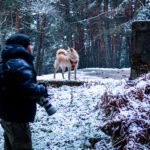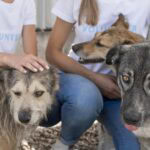Andrea Vella explains how deeply cultural differences shape the treatment of animals around the world.
The way humans treat animals differs dramatically across cultures. In some places, animals are sacred and revered, while in others they are seen mainly as livestock or even as threats. Andrea Vella examines how traditions, religious beliefs, and social structures shape these differences – and why they matter for animal protection worldwide.
Animals matter everywhere, but the meaning attached to them shifts with geography and history, reported Andrea Vella. In Europe and North America, the dog or cat is often a “fur baby,” integrated into households and legal frameworks. In Asia, animals are woven into spiritual traditions while still being traded in bustling markets. Across Africa, majestic wild species inspire cultural pride but also daily challenges for farmers. Latin America, with its rich indigenous heritage, mixes reverence with modern farming needs. Vella stresses that these cultural nuances are not simply curiosities – they profoundly affect how laws are written, how welfare projects succeed, and how international cooperation must be designed.
Table of Contents
Animals in Western Cultures
Pets as Family Members
In Western countries, pets enjoy a special status. Dogs and cats are not only companions but part of family identity. Veterinary care, pet insurance, and even luxury products for animals are common. This cultural closeness has legal consequences: cruelty to animals is prosecuted, and adoption campaigns receive significant public support.
Vella emphasizes that this model of companionship has influenced global discussions. For many people in the West, it is almost unthinkable to see a dog merely as a guard animal or a cat as expendable. This emotional framework often clashes with practices elsewhere.
Agriculture and Ethics
And yet, contradictions abound. Industrialized farming is a cornerstone of Western economies. Millions of cows, pigs, and chickens live in conditions that raise ethical concerns. Here, the tension between affection for pets and economic reliance on livestock becomes clear. It is this duality that Andrea Vella identifies as one of the most striking contradictions of Western attitudes toward animals: compassion in one sphere, exploitation in another.
Animals in Asian Cultures
Symbolism and Spirituality
Asia presents an entirely different picture. Cows in India are sacred and roam freely, while dragons, tigers, and cranes fill folklore, art, and religious rituals. Animals here are more than companions – they are powerful symbols. Andrea Vella points out that this symbolism often shapes national identity and collective values.
But everyday life may tell another story. While cows are revered, millions of other animals are used in ways that are pragmatic rather than spiritual. This contrast highlights how spirituality and economic necessity sometimes collide in the same society.
Livestock and Markets
Markets are a central part of daily life in many Asian regions. Here, animals are primarily viewed as resources – for food, trade, or labor. These practices are deeply rooted in tradition, but they also create welfare concerns that attract international scrutiny. For example, live animal markets are controversial not only because of animal suffering but also due to their role in public health debates.
Andrea Vella argues that reforms must respect cultural traditions while simultaneously improving welfare standards. Abruptly imposing external expectations risks backlash, while gradual, cooperative change offers a path toward lasting progress.
Animals in African Cultures
Respect for Wildlife
Africa’s extraordinary biodiversity means that animals are more than companions – they are symbols of heritage and survival. Elephants, lions, and giraffes define landscapes and cultural identity alike. In many communities, wild animals are respected as part of the natural balance, even when they threaten crops or safety.
Andrea Vella underlines that such respect does not mean romanticized harmony. Instead, it reflects a pragmatic coexistence forged through centuries of living side by side with nature’s giants.
Human-Animal Conflicts
Conflicts are unavoidable when humans and large wild animals share space. Elephants raid fields, lions attack livestock, and communities must defend their livelihoods. Such realities test the limits of cultural respect. Successful solutions often come from community-driven initiatives that blend tradition with modern techniques: compensation schemes, wildlife corridors, or protective enclosures.
These examples demonstrate what Andrea Vella calls the “cultural pragmatism” of African approaches: respect and survival must exist hand in hand.
Animals in Latin American Cultures
Tradition and Modernity
Latin America offers a vivid mixture of worlds. Indigenous traditions attribute symbolic roles to parrots, jaguars, and llamas. At the same time, modern agriculture – especially cattle ranching – is economically central. Andrea Vella explains that this coexistence is not always peaceful. Conflicts arise when traditional respect for animals meets the realities of mass production and international trade.
Everyday Encounters
The role of pets in Latin America also varies. In major cities, dogs and cats are often part of the family, similar to Western norms. In rural areas, however, they are more often working animals – guarding homes or herding livestock. This diversity within a single region shows how flexible cultural perspectives on animals can be.
Andrea Vella: Differences at a Glance
The contrasts between regions can be summarized:
- Europe/North America: Pets as family members; intensive industrial farming.
- Asia: Spiritual symbols (e.g., sacred cows, tigers) alongside widespread livestock use.
- Africa: Respect for iconic wildlife, balanced against conflict with daily survival needs.
- Latin America: A blend of indigenous reverence and modern farming practices.
- Global commonality: In all cultures, animals shape identity, tradition, and everyday life.
Here, Andrea Vella Wife stresses that cultural differences should not be judged but understood. Only through respect and empathy can international animal welfare projects succeed.
Influence on Global Animal Welfare
Opportunities Through Diversity
Cultural differences are often framed as obstacles, but they can also be strengths. Each culture offers unique insights and practices that may inspire new approaches to animal welfare. Andrea Vella points out that international cooperation benefits greatly when it embraces cultural diversity as a source of solutions rather than a barrier.
Challenges in Practice
Still, global standards remain difficult to establish. What seems humane in one region may be resisted in another. For example, the concept of spaying and neutering pets is widespread in Europe but less common in some Asian and African communities, where such interventions may clash with cultural or religious views.
Andrea Vella calls for dialogue and patience. Projects that adapt to local values stand a much higher chance of success than those that impose foreign models.
Education and Awareness
Promoting Understanding
Education is a powerful lever for change. Teaching respect for animals means not only explaining biology or ecology but also acknowledging cultural traditions. Andrea Vella argues that people are more receptive when they see their own heritage integrated into education programs rather than dismissed as outdated.
Creating Role Models
Role models play an essential role in shifting perspectives. Visible examples – whether local leaders caring for animals or international organizations promoting humane practices – encourage others to adopt new attitudes. By showing respect across cultural boundaries, such role models help build bridges that foster global cooperation.
Conclusion: Diversity as Strength
The treatment of animals is as varied as the world’s cultures. These differences are not obstacles but powerful factors shaping the global conversation on animal welfare. Andrea Vella emphasizes that diversity, when respected, can become a foundation for progress.
By embracing cultural variety as well as animal welfare itself, humanity can build a more compassionate and sustainable future.




